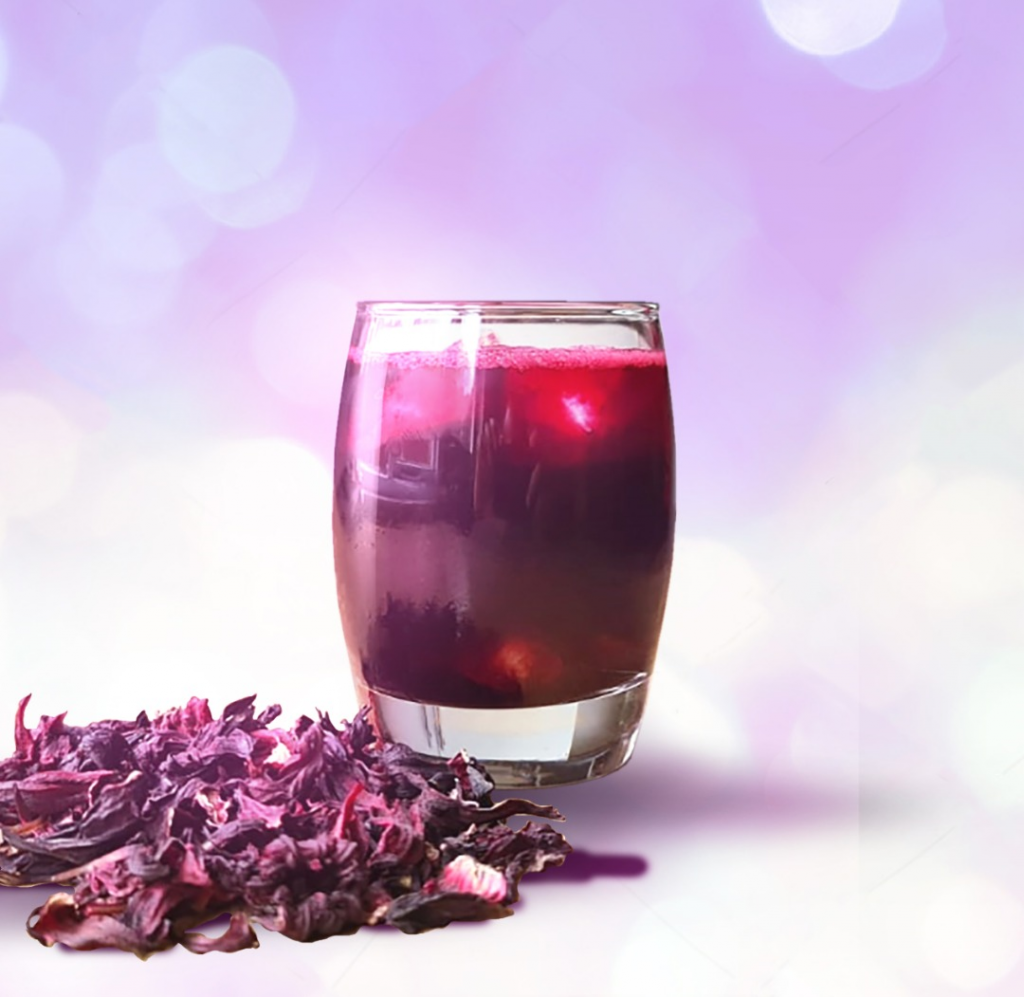Hibiscus is a genus of flowering plants in the mallow family, Malvaceae. The genus is quite large, comprising several hundred species that are native to warm temperate, subtropical and tropical regions throughout the world. Member species are renowned for their large, showy flowers and those species are commonly known simply as “hibiscus”, or less widely known as rose mallow. Other names include hardy hibiscus, rose of Sharon, and tropical hibiscus.
A tea made from hibiscus flowers is known by many names around the world and is served both hot and cold. The beverage is known for its red colour, tart flavor, minerals and vitamin C content.

Beverage
It is known as bissapin West Africa, “Gul e Khatmi” in Urdu & Persian, agua de jamaica in Mexico and Central America (the flower being flor de jamaica) and Orhul in India. Some refer to it as roselle, a common name for the hibiscus flower. In Jamaica, Trinidad and many other islands in the Caribbean, the drink is known as SORREL( Hibiscus sabdariffa); not to be confused with Rumex acetosa, a species sharing the common name sorrel). In Ghana, the drink is known as soobolo in one of the local languages.
In Cambodia, a cold beverage can be prepared by first steeping the petals in hot water until the colors are leached from the petals, then adding lime juice (which turns the beverage from dark brown/red to a bright red), sweeteners (sugar/honey) and finally cold water/ice cubes.
In Egypt, hibiscus tea is known as karkadé (كركديه), and is served as both a hot and a cold drink.
Hibiscus tea can also be flavored with mint, ginger, pineapples and oranges in West Africa. In Ghana it is known as “sobolo”, and “zobo” in Nigeria. Karkadé is served hot or chilled with ice in North Africa.
BENEFIT
Hibiscus rosa-sinensis is described as having several medical uses in Indian Ayurveda. It has been claimed Hibiscus flower is;
- Packed with antioxidants
- May help lower blood pressure
- May help lower blood fat levels
- May boost liver health
- Could promote weight loss
- Contains compounds that may help prevent cancer
- Could help fight bacteria
- Flavorful and easy to make
The flowers and leaves can be made into teas and liquid extracts that can help treat a variety of conditions.
Hibiscus has been used by different cultures as a remedy for several conditions. Egyptians used hibiscus tea to lower body temperature, treat heart and nerve diseases, and as a diuretic to increase urine production.
In Africa, hibiscus tea was used to treat constipation, cancer, liver disease, and cold symptoms. Pulp made from the leaves was applied to the skin to heal wounds. I love hibiscus drink because of its detoxification quality; whenever I drink hibiscus, it seems to have a cleansing effect in my system. Also because it’s a no calorie drink by itself alone, I drink it all the time especially when I feel like nibbling something or thirsty.
In Iran, drinking sour tea is still a common treatment for high blood pressure.
Today, hibiscus is popular for its potential to reduce high blood pressure. Modern studies show promise for both the tea and hibiscus plant extract to lower blood pressure and cholesterol levels. Although more research is still needed, this could be good news for the future of heart disease treatment.
Hibiscus shows potential for cancer treatment and as a weight loss aid, along with other uses. There are not many studies in these areas, but some Research Trusted Source suggests that anthocyanins may hold the key to hibiscus’ anticancer properties.
Another recent study, Trusted Source found that hibiscus extract might have an effect on metabolism, preventing obesity and fat buildup in the liver. The tropical plant has even been used successfully as part of an herbal extract mixture to treat head lice.
Hibiscus flowers come in many colours, but the red flowers of this variety are most commonly cultivated for medical purposes and are available as dietary supplements.
Hibiscus tea, also called sour tea because of its tart taste, is made from dried hibiscus flowers, leaves, and dark red calyces (the cup-shaped centers of the flowers). After the flower finishes blooming, the petals fall off and the calyces turn into pods. These hold the plant’s seeds. Calyces are often the main ingredients in herbal drinks containing hibiscus.
Hibiscus tea and extract can be purchased at health food stores as dietary supplements. There is no recommended dose because this depends on the product you purchase and why you are using it. The typical amount of calyx in one serving of tea is 1.5 grams, but studies have used as much as 10 grams of dried calyx, and extracts containing as much as 250 milligrams of anthocyanins.
When used as a tea, hibiscus is generally considered safe. But more research is needed to determine a safe dosage for pregnant or breastfeeding women, children, and people with liver or kidney disease.
Hibiscus tea is very tart and might be more so to sensitive tissues. Listen to your body and if it makes you feel ill, discontinue use.
Hibiscus remains a popular herbal remedy in countries throughout the world. As research continues, it may become more widely accepted as an effective medical treatment.
Source
Source
